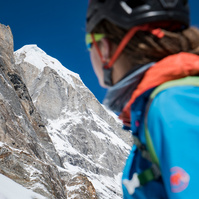Two Attempts Mt Nilkantha Garhwall India
Words by: Anne Gilbert Chase
I recently returned to the U.S. from my first trip to the Indian Himalaya. Jason Thompson and myself received a Mugs Stump Award and a Lyman Spitzer Grant to attempt the unclimbed South Face of Hathi Parbat. Unfortunately because of its proximity to the China border our permit was denied. With only a week last spring to regroup and pick another objective, we decided to try the Southeast Ridge on Mt. Nilkantha (6596m). The SE ridge had been attempted 6 times between 1937 and 1992 but had never seen an ascent due to its “long and tortuous nature”. The ridge is 2.7km long and has seven pinnacles and a 100m granite slab that must be overcome before one can reach the summit ridge. Despite the many obstacles presented, if conditions and the weather were good, we felt we had a good shot at climbing this impressive ridge.
In late September, Jason Thompson and myself met up with Caro North in New Delhi and after a day of last minute shopping and meeting with the Indian Mountaineering Federation, we started our journey North toward Nilkantha. Our trek began a few kilometers south of the town of Badrinath, and after 3 days of trekking we reached our basecamp (4100m) on the Panpatia glacier. We quickly got to work acclimating and putting ourselves in place for the SE ridge. From our BC we could not see the lower half of the SE ridge so in order to see the route and conditions we had to hike 5 hours up grassy slopes and loose talus fields. The weather was quite unstable for the first 10 days and almost every day clouds would rise from the valley below and engulf the mountain, often times producing precipitation. The temperatures were unseasonably warm, so the precipitation was typically wet snow and would melt off quickly in a few hours of sun. After 10 days or so of acclimating and carrying loads up to our advanced base camp at 5000m, we got a clear weather window and were ready to start climbing on the SE ridge.
The first 300m of climbing was on very loose rock and faceted snow, making for slow moving and tough conditions. Unfortunately the conditions did not improve the higher we climbed and after spending a full day climbing on the ridge, we decided that the conditions were too dry and the route was not in shape for us to safely continue climbing. Although, it was a tough decision to make, it was a decision that all three of us agreed upon and knew was the right call. At this point we decided to regroup and attempt the Southwest face, which Marko Prezelji had hoped to climb in 2001, but was unable due to poor conditions and weather.
After a few days of rest in BC, the weather was still good, so we decided to climb the West ridge, which would be our descent route from the SW face. On October 7th we established our ABC at 5100m below the SW face and started to climb early on the morning of the 8th. Conditions were not easy due to the dry season. With lots of loose rock and no ice, the climbing was more demanding than we had originally thought. There was a lot of tattered fixed ropes left behind from the 2007 Calcutta expedition, which we did not use. At about 5600m we established an uncomfortable bivy and continued to climb the next day. Around 4pm and 6400m on the summit ridge after 13 hours of climbing, a strong storm came in producing grapple and snow, as well as static electricity. With all three of us feeling the electrical shocks in our bodies from the storm we knew that continuing to the summit was not an option. We began our long decent back down the west ridge, reaching our bivy around 5am. We brewed up and slept for a few hours, after which we packed everything up and continued to rappel the lower half of the mountain reaching our ABC at 5pm on October 10th. Despite a large amount of falling rocks, stuck ropes, and a crushed helmet we safely made it back down to our BC the following day. Despite our disappoint in not summiting via the West ridge, our mission of scouting the decent route was a success and now we were ready to attempt the main objective of climbing the SW face. We rested back in BC for a few days and began the reorganizing and repacking process to head back up to our ABC. Unfortunately the weather began to shift at this point and our window of opportunity was growing smaller. The snow continued in BC for a few days and the small glimpses of the upper mountain we could see, showed a thick layer of snow accumulating on all aspects. We remained hopeful that the snow would stop and we would be awarded another attempt on the mountain. However, after a few more days of continued snow and a grim weather forecast we knew our trip was over. On the 18th of October we packed up our BC and along with our cook and porters, we made a 2-day trek back to the road head.
I want to thank the American Alpine Club for this amazing opportunity. Without the support of these grants this trip would not have been a possibility. Of course we would’ve loved to have climbed Mt. Nilkantha via a new route, but failure is part of climbing in the mountains. We still climbed an amazing route in the Himalaya and learned a lot about our personal abilities at altitude. Most importantly we all made it home safely from this climbing trip, and for that I am grateful.









